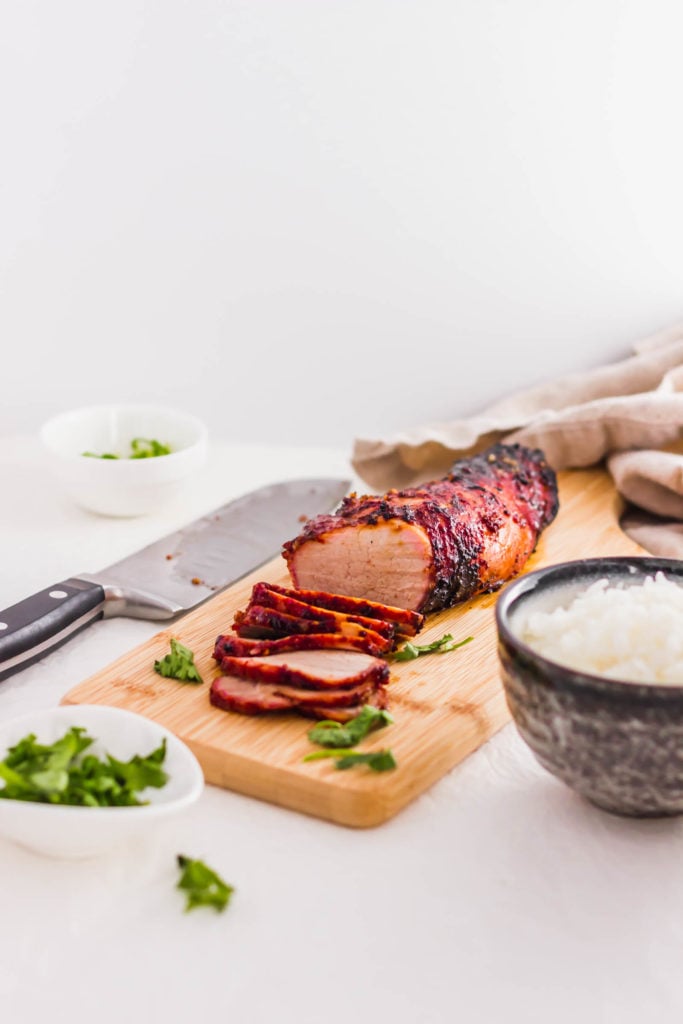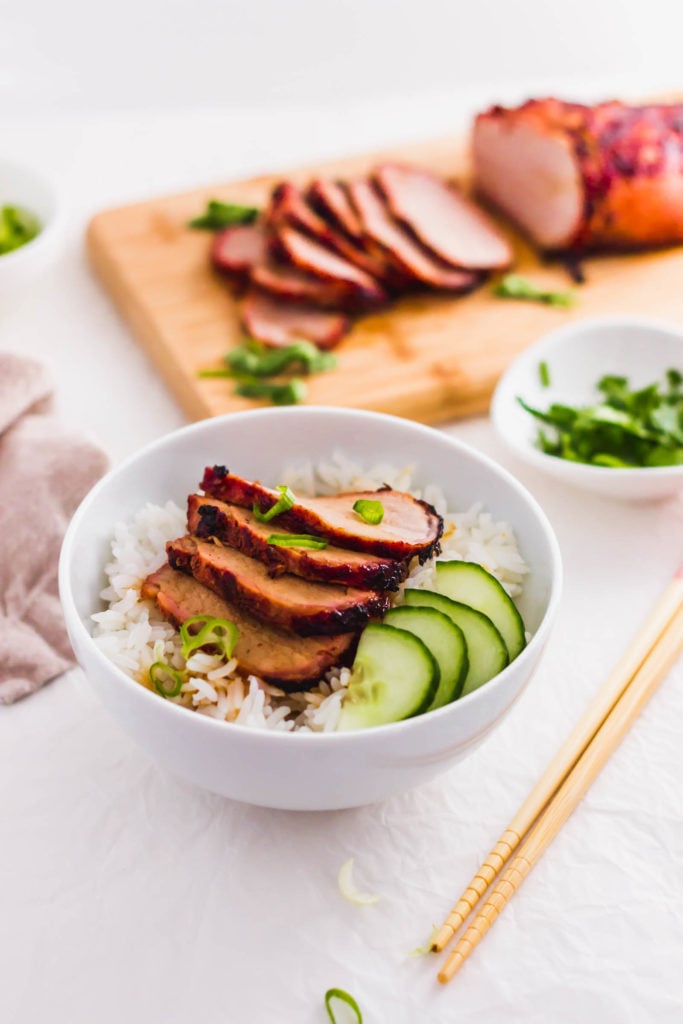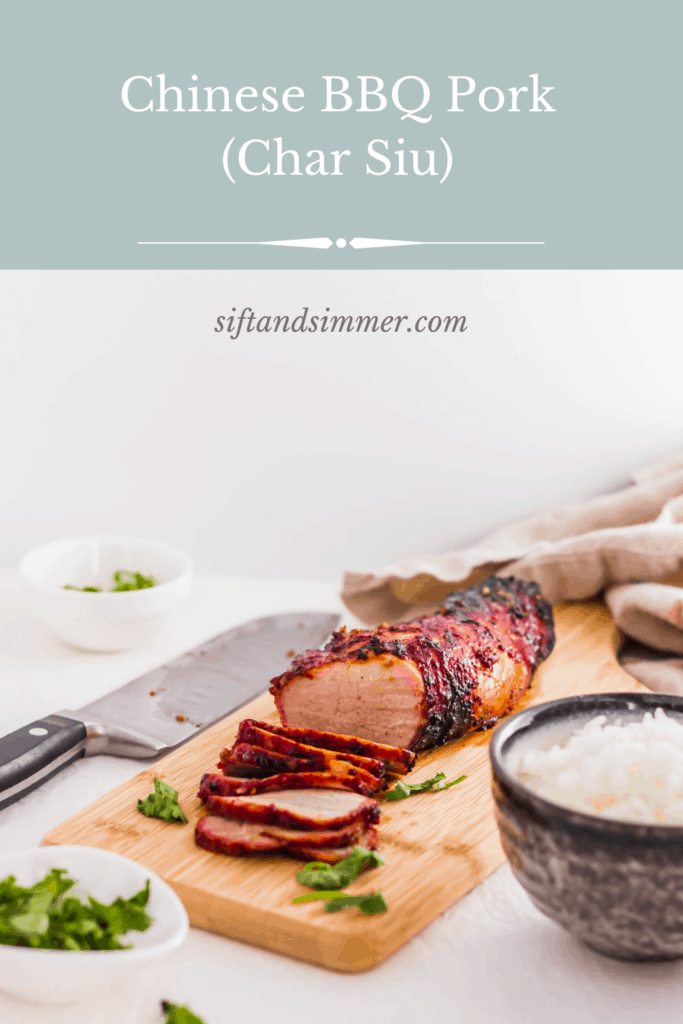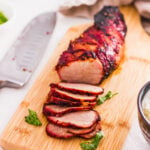This recipe for Cantonese-style Homemade Char Siu Roasted BBQ pork that yields a tender, flavourful meat similar to what you would find at a Chinese BBQ meat shop. It's a staple ingredient in Steamed BBQ Pork Buns and it's delicious over rice or noodles.
Want to save this recipe? Enter your email & I'll send it to your inbox. Plus, get great new recipes from me every week!
Growing up, my first memories of eating char siu were when my family would visit my grandparents who lived in the city.
My grandfather would bring back mysterious white styrofoam boxes, and my grandmother would cook rice and boil vegetables.
When it was time to eat, my grandfather would open the styrofoam box to reveal roasted, sliced meat in the form of char siu (BBQ pork), and roasted duck.
The aroma of the roasted meats would fill the kitchen, and I remember eagerly having hot steamed rice and eating it with the savoury meats.

When I was a little older, I remember visiting Chinatown with my parents and seeing them stop in Chinese BBQ meat shops, where all they would serve were these roasted meats.
Roasted BBQ pork (char siu), roasted pig, duck... the meats would all be on display.
Why you'll love this recipe
The flavour of char siu is savoury, sticky and slightly sweet, and has an aromatic fragrance from the 5-spice powder.
It's tender and juicy, which pairs well with steamed rice or noodles.
It's easy to make and you can do it at home without any fancy equipment.
What is char siu?
Char siu literally means "fork" (char) "roasted" (siu), which refers to the way the meat is prepared.
The meat is skewered onto a long fork and roasted over a fire, similar to BBQ.
Typically, Cantonese-style char siu is made with pork -- either a pork shoulder or pork tenderloin.
At dim sum restaurants, you'll find char siu in many dishes:
Where can you find it?
You can find char siu at Chinese BBQ meat shops and some Asian supermarkets.

Ingredients you'll need
I use pork tenderloin, as it is a lean and tender cut of meat.
Marinate the pork in a mixture of:
- maltose: adds sweetness to the pork; you can use honey if you can't find maltose
- light soy sauce: adds salty flavour to the pork
- 5-spice powder: is blend of spices commonly used in Chinese cuisine, consisting of star anise, cloves, Chinese cinnamon, Sichuan peppercorns and fennel seeds. Its aromatic, lightly floral flavour is great in meats, like my 5-Spice Turkey Green Onion Pancake Rolls.
- hoisin sauce: which is a sweet and salty sauce that is made from soy beans
- red fermented tofu bean curd: is dry firm tofu that is soaked in a brine and has a salty taste. It get its red colour from red yeast rice.
- Chinese rose wine: If you're unable to find Chinese rose wine, you can substitute with a Shaoxing wine. Or try a dry white wine, for additional flavour.
You can find all these ingredients in Asian supermarkets.
The red ring
The hallmark of char siu is the red ring around the perimeter of the pork, similar to a smoke ring you would see on western BBQ'd meat.
Some places use artificial red food colouring to achieve this.
However, since I try to avoid food colouring, the maltose and red fermented tofu bean curd will produce great results.

How to cook the pork
After marinating the pork, you can cook it over a grill.
This method mimics the flavour of what you would find at a Chinese BBQ shop.
However, you can also roast the pork in the oven just the same.
How to serve
Slice it up and alongside with rice or noodles, other meats, and vegetables.
Serve it warm.
How to store
Store the the cooked roasted pork in an airtight container in the fridge for up to 1 week.
Alternatively, you can slice it up and freeze it in a freezer-safe container for up to 3 months.
Way to use it
Slice the pork up and lay it on a bowl of rice.
Use it as a filling for Baked BBQ Pork Buns or Steamed BBQ Pork Buns (Char Siu Bao).
Add it on top of Kolo Mee noodles.
Other recipes you may like
You may also like these recipes:
Steamed BBQ Pork Buns (Char Siu Bao)
Homemade Chinese BBQ Pork Pastry (Char Siu Sou)
Kolo Mee (Dry Sarawak Malaysian Chinese Noodles)
Braided Pork Floss Green Onion Buns
Let me know if you try my recipe! Tag me on Instagram @siftandsimmer or leave me a comment/rating below.

Homemade Char Siu (Chinese Roasted BBQ Pork)
For accuracy and precision in baking recipes, use weight (metric) measurements when available.
Ingredients
- 2 lbs pork tenderloin or pork shoulder
- 6 cloves garlic finely minced
- ½ teaspoon grated ginger
- 2 tablespoon light soy sauce
- 2 tablespoon hoisin sauce
- 2 cubes red fermented tofu bean curd + 1 tablespoon sauce optional
- 2 tablespoon Chinese rose rice wine or use shaoxing wine, or a dry white wine
- 1 teaspoon 5-spice powder
- 1 teaspoon sesame oil
- 2 tablespoon maltose or substitute honey
- 1 tablespoon honey for brushing on
Instructions
Prepare the pork:
- Clean and trim the pork. If using pork shoulder, cut the pork into long strips about 2" wide.
- In a large bowl, combine minced garlic, grated ginger, soy sauce, hoisin sauce, red fermented tofu bean curd (and sauce), rose rice wine, 5-spice powder, sesame oil, and maltose (you can use the same amount of honey if you don't have maltose on hand).
- Add the pork into the marinade and use a spoon to scoop the marinade on top of the meat so that all portions of the meat absorb the marinade.
- Cover and set aside in the fridge for at least 12-24 hours.
- Remove the meat from the fridge at least 1-2 hours before roasting/grilling.
BBQ:
- Heat grill to 400°F.
- Place meat on the grill.
- Brush marinade on the meat. Cook for 15 minutes on one side and flip. Continue cooking until the meat reaches an internal temperature of 145°F, approximately another 10 minutes.
Oven:
- Preheat oven to 400°F/204°C.
- Place meat on an aluminium foil-lined baking tray. Brush with the marinade and roast for 20-25 minutes, or until the internal temperature of the meat reaches 145°F.
- Remove from heat, brush honey on top and let the meat rest for 10-15 minutes before slicing.
- Serve on top of steamed rice and vegetables.
Nutrition
The nutritional information provided should be considered as approximate and is not guaranteed. Please use your best judgment to ensure food is safely prepared and/or a good fit for your diet.
This article was originally published for Curious Cuisiniere.






Leave a Reply